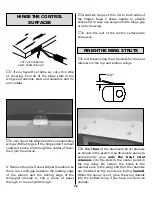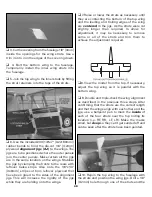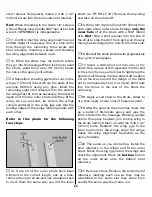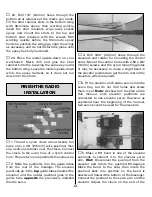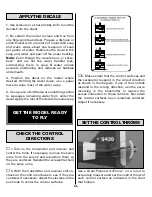
Mount the bottom wing to the fuselage with the
1/4-20 x 2" [50mm] nylon wing bolts and 1/4"
[6mm] washers to hold the aft landing gear wire
to the wing. Be certain the #2 x 1/2" [13mm]
screws that hold the landing gear straps over
the forward landing gear wire are tight. Mount
the top wing with the struts and screws. A small
drop of non-permanent threadlocker on the
threads of the screws for the wing struts is
recommended.
The Dynaflite S.E.5a handles well on the
ground–similar to most tail draggers such as a
Mustang and even easier than some tail
draggers such as a Cub. The S.E.5a does,
however, weathervane easily in crosswinds so
be sure to use the high-rate for the rudder.
Before taking off, see how the model handles
on the ground by doing a few practice runs at
low speeds
on the runway. Hold “up” elevator
to keep the tail wheel on the ground. If
necessary, adjust the rudder so the model will
roll straight down the runway. If you need to
gather your thoughts before the maiden flight,
shut the engine down and bring the model back
into the pits. Top off the fuel, then check all
fasteners and control linkages for peace of mind.
Remember to takeoff into the wind. When
ready, point the model straight down the
runway, hold a bit of up elevator to keep the tail
on the ground to maintain tail wheel steering,
then gradually advance the throttle. As the
model gains speed decrease up elevator
allowing the tail to come off the ground. One of
the most important things to remember with a
tail dragger is to always be ready to apply
right
rudder to counteract engine torque. Gain as
much speed as your runway and flying site will
practically allow before gently applying up
elevator, lifting the model into the air. At this
moment it is possible that additional right
rudder will be required to counteract engine
torque. Be smooth on the elevator stick,
allowing the model to establish a
gentle
climb
to a safe altitude before turning into the traffic
pattern established at your field.
In its time, the British Royal Aircraft Factory
S.E.5a was a groundbreaking aircraft with
exceptional climb rates and dog-fighting
abilities. Powered with the recommended
FLIGHT
TAKEOFF
FIELD ASSEMBLY
CAUTION
(THIS APPLIES TO ALL R/C
AIRPLANES): If, while flying, you notice an
alarming or unusual sound such as a low-
pitched “buzz,” this may indicate control
surface
flutter. Flutter occurs when a control
surface (such as an aileron or elevator) or a
flying surface (such as a wing or stab) rapidly
vibrates up and down (thus causing the
noise). In extreme cases, if not detected
immediately
, flutter can actually cause the
control surface to detach or the flying surface
to fail, thus causing loss of control followed
by an impending crash. The best thing to do
when flutter is detected is to slow the model
immediately by reducing power, then land as
soon and safely as possible. Identify which
surface fluttered (so the problem may be
resolved) by checking all the servo grommets
for deterioration or signs of vibration. Make
certain all pushrod linkages are secure and
free of play. If it fluttered once, under similar
circumstances it will probably flutter again
unless the problem is fixed. Some things
which can cause flutter are; Excessive hinge
gap; Not mounting control horns solidly;
Poor fit of clevis pin in horn; Side-play of wire
pushrods caused by large bends; Excessive
free play in servo gears; Insecure servo
mounting; and one of the most prevalent
causes of flutter; Flying an over-powered
model at excessive speeds.
62
Summary of Contents for Dynaflite S.E.5a
Page 9: ...9 Die Drawing...
Page 10: ...10 Die Drawing...

